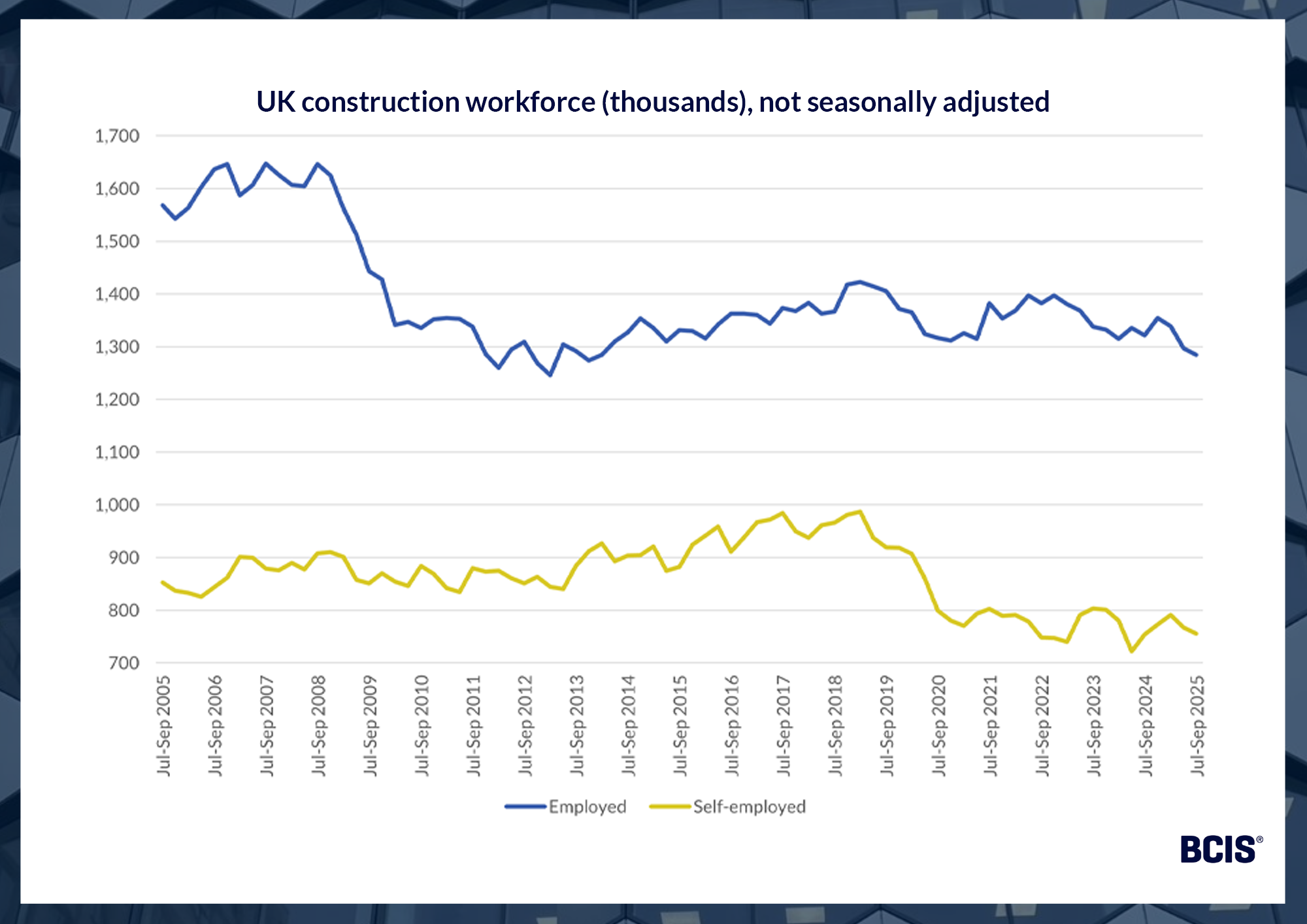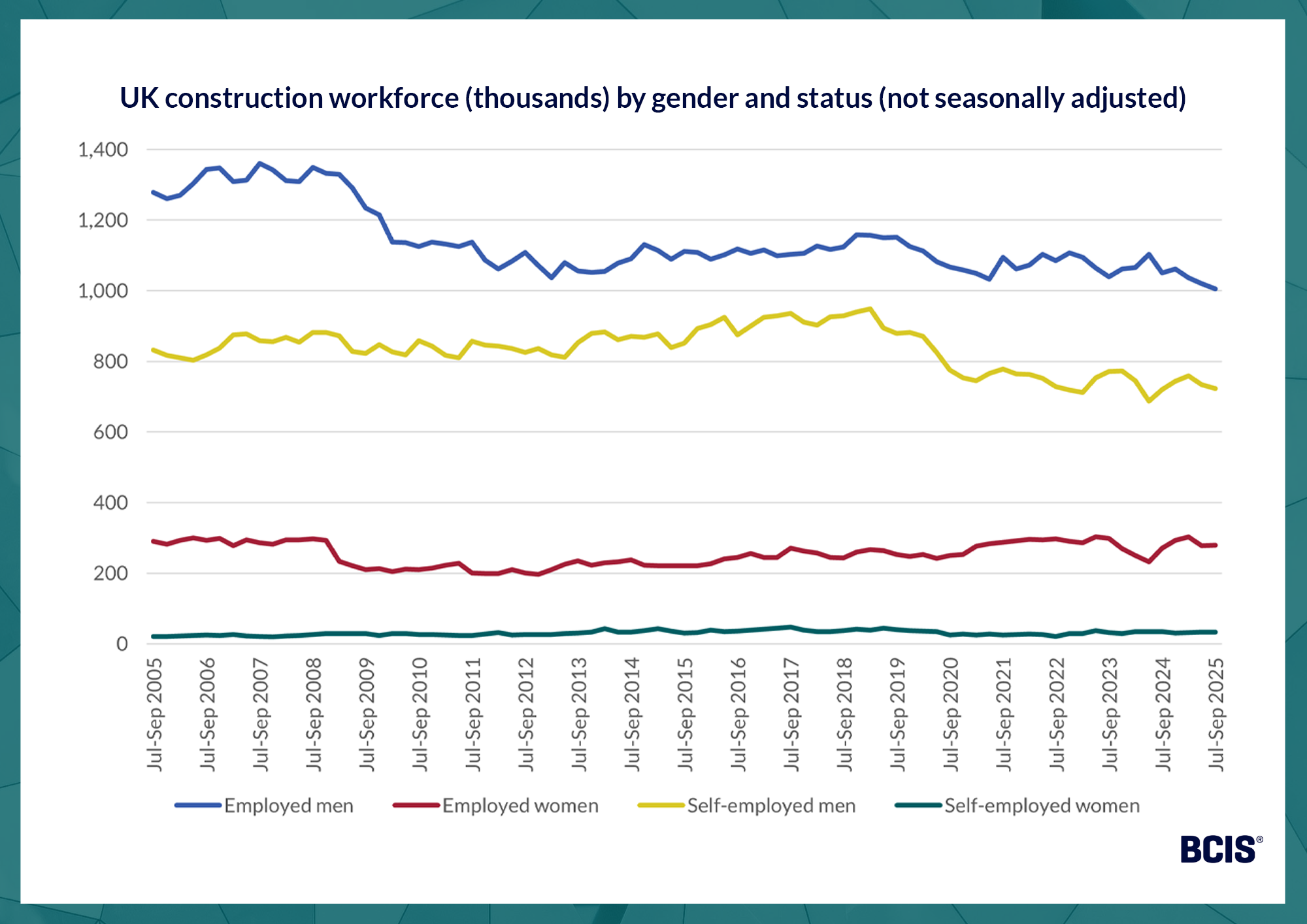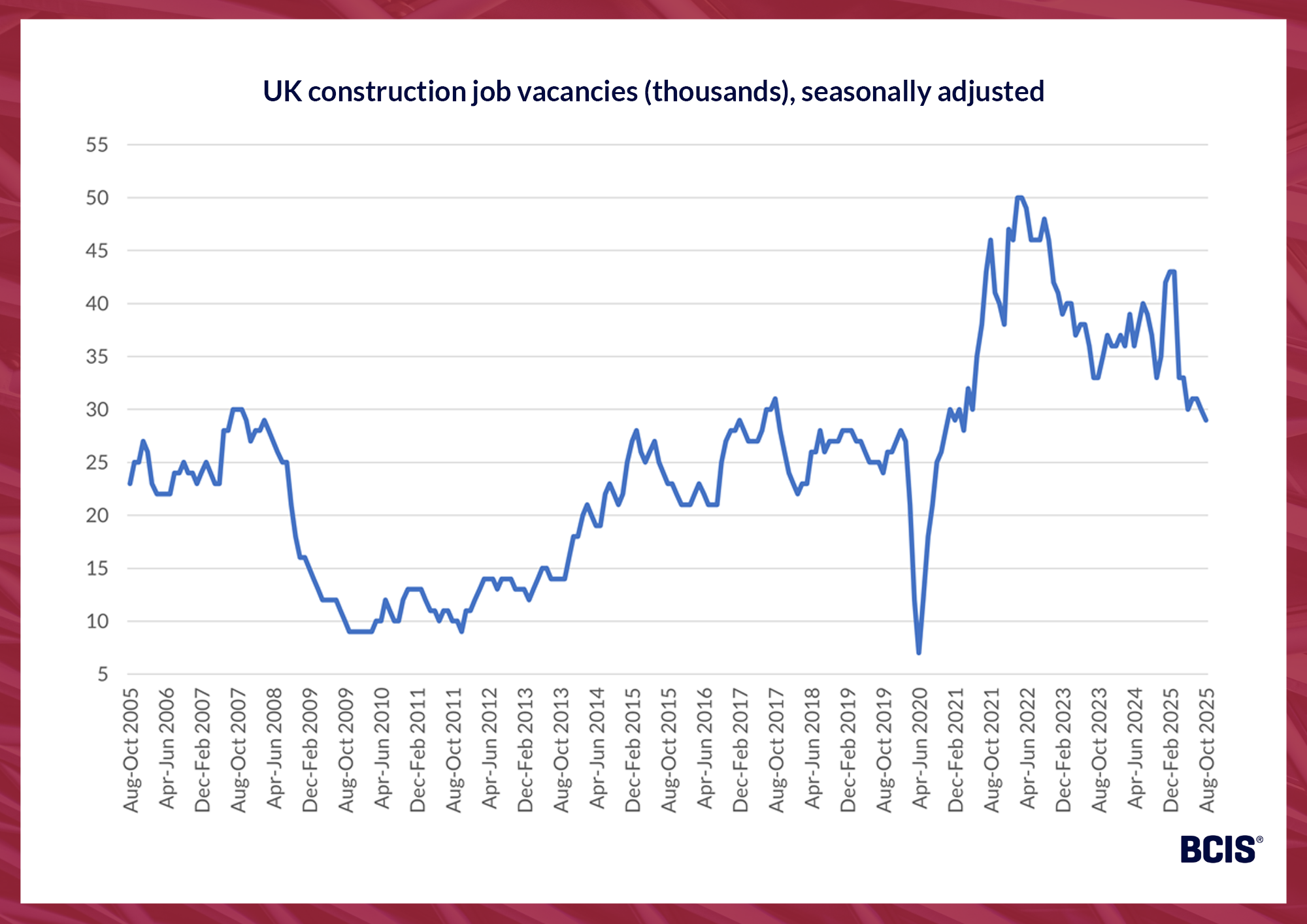If you are a housebuilder or developer, please fill in the survey. If you have any questions or would like to discuss the survey, please call +44 0330 341 1000 or email contactbcis@bcis.co.uk
Published: 13/11/2025
The Office for National Statistics (ONS) publishes quarterly data(1) measuring the number of employees and self-employed people in the UK by industry and gender. This data, which is not seasonally adjusted, is based on the Labour Force Survey (LFS) and aims to provide a current snapshot of employment trends and insight into the labour markets of specific industries.
In the last couple of years, ONS has made several changes to address quality concerns with the LFS(2) and caution has been advised in using these statistics.
Construction workforce shrinks further in 3Q2025
The UK construction workforce (not seasonally adjusted) shrank to its lowest level in almost 25 years in the third quarter of 2025, according to the latest employment data from the ONS.
There were 2,054,009 workers in construction in 3Q2025, a 1.3% decrease on the previous quarter, and a 1.6% decline year-on-year.
This meant the size of the workforce remained 12% lower than in pre-pandemic 3Q2019, with 280,855 fewer workers.
Compared with 3Q2008, at the start of the global financial crisis, the workforce has shrunk by just shy of 530,000 workers.
Dr David Crosthwaite, chief economist at BCIS, said: ‘The latest employment figures are a stark reminder of how far capacity has eroded, and the national picture isn’t much better. UK unemployment has risen to 5%, the highest since early 2021. It adds to a difficult economic mix where inflation remains elevated and growth has stalled – a combination described as stagflation, where prices stay high even as the economy and jobs market weaken.’
Employed and self-employed workers
In 3Q2025, there were 1,284,405 employed workers and 755,576 self-employed workers in construction. Self-employed workers therefore accounted for 37% of the overall workforce, the same proportion as has been the overall average level of self-employment in the sector since 1997.
The number of employed workers in 3Q2025 was down by 0.9% on the quarter and 2.8% on the year.
Self-employed workers in construction decreased on the quarter by 1.5%, but rose slightly by 0.2% on the year.
Dr Crosthwaite added: ‘Within construction, the most striking trend is the sharp drop in self-employment since 2019, likely driven by retirements and Brexit, as well as the pandemic. That loss of flexibility makes it harder for the sector to respond to changes in demand.
‘While labour shortages are often cited as a constraint, the deeper issue right now is subdued activity. With confidence low and projects stalling, workforce contraction is as much a symptom of fragility as a cause. The ONS has also advised that the latest employment data should be treated with caution due to ongoing issues with the Labour Force Survey, which has faced difficulties maintaining a representative sample since the pandemic. Even so, the trend is clear – construction capacity continues to shrink.
‘We know that labour pressures are being priced into tender returns and early-stage estimates, not helped by increases to firms’ employment costs, but the industry’s more pressing concern is the economic backdrop firms are struggling to operate in.
‘Unless the government takes urgent action to support businesses and inject some momentum into the economy, we risk shedding even more of the workforce needed to deliver growth when demand does return. The real tension in the supply chain lies in getting the right skills in the right place at the right time, and that becomes almost impossible when activity is stagnating.
‘In previous decades, the UK has relied on overseas labour to fill gaps in its workforce, but the current government is set on growing domestic capacity. The challenge with that is timing – those ambitions take years to realise, while the market’s needs shift month to month.’
Source: ONS
The construction gender divide
Breaking down the figures by gender, 85% of all construction workers in 3Q2025 were men, with 316,816 women working in the industry in total.
Among employed workers, the number of male workers decreased on the quarter (1.4%), while the number of women employees increased by 0.8% in the same period. The number of employed men in construction decreased by 4.3% on the year while employed women increased by 3%.
By comparison, self-employed men decreased by 1.5% on the quarter and rose by 0.4% annually. The number of self-employed women fell by 1.3% on 2Q2025 and by 3.9% on the year.
Source: ONS
Job vacancies in construction
New figures from the ONS Vacancy Survey – a regular survey that provides estimates of the number of available positions in the economy – show that in the three months to the end of October 2025, there were approximately 29,000 job vacancies in the construction sector (seasonally adjusted)(3), at a ratio of 1.9 vacancies per 100 filled positions (excluding self-employment).
Compared with the same period in 2024, this was approximately 8,000 fewer vacancies.
Since the start of 2025 (the three months ending in January 2025), vacancies have decreased by almost one-third, or by 13,000.
Source: ONS
Dr Crosthwaite added: ‘The fall in vacancies reflects a market that’s easing rather than expanding. Recruitment pressures have clearly lessened, but that’s largely because demand has cooled, not because capacity constraints have improved.
‘When vacancies, employment and output are all moving in the same direction, it underlines that the more pressing issue isn’t a shortage of workers, it’s a shortage of work. Until activity levels recover, it’s hard to see meaningful growth in construction employment.’
To keep up to date with the latest industry news and insights from BCIS, register for our newsletter here.



